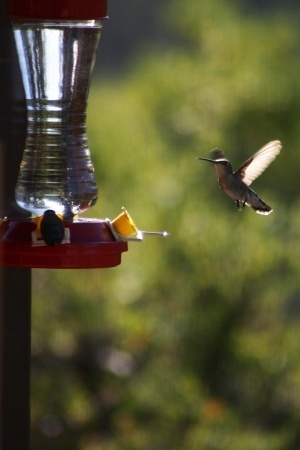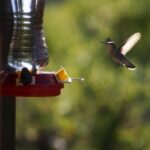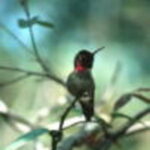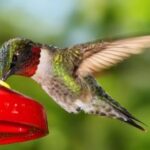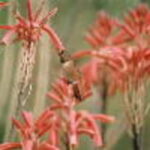Virginia has a lot to offer visitors, from beaches to mountains, from a past rich in history to modern day attractions, not to mention music and shopping to enjoy. However, not all visitors to Virginia are attracted to these types of tourist attractions. The tiniest visitors to this state, the ones who return each year beginning in mid-April, are more attracted to red, orange and yellow blooming flowers and feeders that contain the much sought after sugar-water ‘nectar’ that they crave. Of course, I am speaking of the tiny hummingbird and its annual migration, which includes stops in Virginia.
The Ruby-throated Hummingbird is the most commonly seen hummingbird in all of America, and Virginia is no different. This hummingbird begins making its appearance in Virginia during mid-April, when the males of the species arrive, followed shortly, usually in May, by the females of the species. Even though the most common hummingbirds to visit Virginia are the Ruby-throated Hummingbird, there have been sightings, although rare, of other species, including the Rufous Hummingbird, the Magnificent Hummingbird, the Black-chinned Hummingbird and the Allen’s Hummingbird.
Hummingbird enthusiasts often delight in the ability to distinguish one species from another, especially when there is the possibility of another species enjoying their feeder or hummingbird garden. The ability of distinguishing between the species has to begin with the identification of these species of hummingbirds in Virginia, which is usually easiest with the males of the species as they are the most colorful.
The male Ruby-throated Hummingbird, being true to its name, has a ruby-red colored throat, which is easily noticed. Below this ruby-red throat is a white collar and chest, emerald green or bronze green head and back that leads to a dark, forked tail with no white tips. The female Ruby-throated Hummingbird is vastly different from the male, beginning with her throat, it is not ruby-red, as the name implies, hers is white and sometimes has light streaking, her three outer tail feathers are white-tipped and like the male her back and head are metallic or bronze green.
The male Rufous Hummingbird, another hummingbird in Virginia that is true to its name, has a rufous face, back, tail and rump, although sometimes the back and crown will be green. This male hummingbird also has a white breast and a brightly colored, orange-red throat. The female Rufous Hummingbird, unlike some males, has a green crown and back, rufous flanks and tail feathers that are rufous at the base. She also has a white belly and breast, a white throat with dark streaks or red spots and white tips on her tail feathers.
The Magnificent Hummingbird is the largest hummingbird species in Virginia, with males weighing 7.7 grams and females weighing 6.4 grams, making them almost twice as large as any of the other species. Their size alone may be enough to identify them, but just in case it is not, the male has a throat that is metallic green, a breast that is black, its forehead and crown are purple and its back is dark green. The female less brightly colored, to the point of almost being drab, with her throat that is gray with light streaks, her breast that is solid gray, her back and crown that are olive green. The brightest color on her whole body is her pearl-gray tipped tail feathers.
The last species of hummingbirds in Virginia that may be seen are the Allen’s Hummingbirds. The male Allen’s Hummingbird has an iridescent copper-red throat, a rufous belly, rump, sides and tail, his breast is white and he has a shimmering green back and crown. The female Allen’s Hummingbird has a throat that is white and has dark flecks, bronze-green back and crown and her belly and breast are rufous and buff colored.
